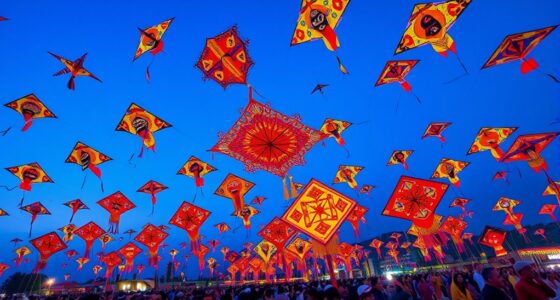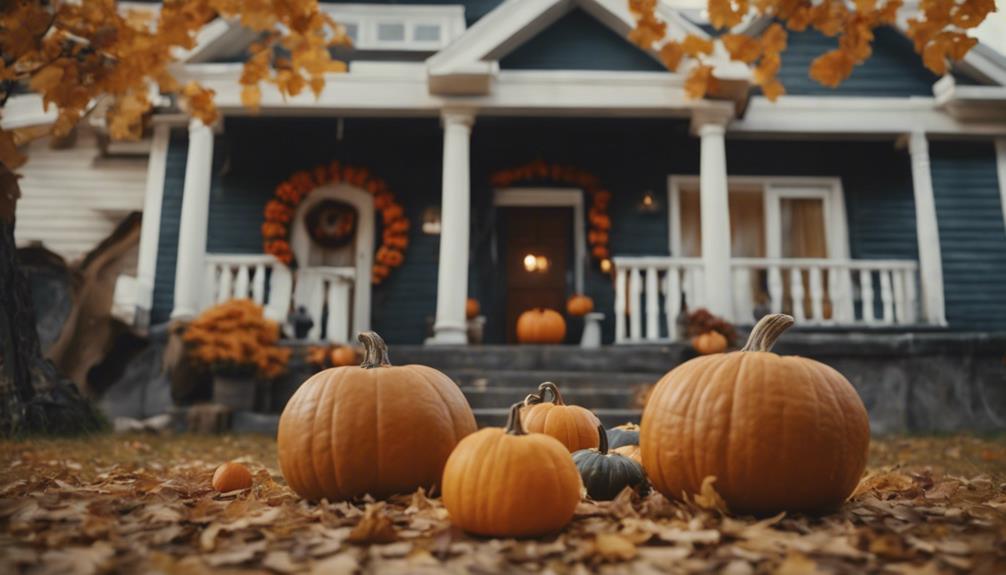Around the world, Halloween foods reflect local customs and creativity. In Mexico, sugar skull candies and pan de muerto honor tradition, while in the U.S., kids enjoy pumpkin-shaped cookies and spooky treats. Japan features colorful bento boxes with playful designs, and in the Philippines, simple, community-focused desserts are popular. Each culture adds its unique flavor and decoration to celebrate the season vividly. Keep exploring to discover more about how different countries make Halloween indulgent and memorable for everyone.
Key Takeaways
- Halloween foods vary globally, reflecting local customs, history, and cultural influences.
- Many countries incorporate themed treats and decorations inspired by costumes and festivities.
- Mexico’s Day of the Dead features sugar skull candies and pan de muerto honoring ancestors.
- In Japan, playful Halloween bento boxes with spooky motifs blend traditional cuisine with festive design.
- The US emphasizes themed candies, cookies, and treats that enhance the spooky atmosphere of Halloween.

Have you ever wondered how different countries celebrate Halloween through their food traditions? As Halloween approaches, you might notice how it’s not just about costumes and spooky decorations but also about the unique treats and dishes that each culture brings to the table. In some places, traditional costumes play a huge role in the festivities, inspiring culinary creations that match the theme. For example, in Mexico, the Day of the Dead celebrations blend vibrant costumes with special foods like sugar skull candies and pan de muerto, a sweet bread shaped like bones. These foods aren’t just delicious; they’re deeply rooted in honoring loved ones who have passed away. Similarly, in Ireland, where Halloween originated, people still craft costumes inspired by ancient Celtic traditions, and their foods often include hearty stews and baked goods that reflect the cold, harvest season. The emphasis on traditional costumes and spooky decorations during Halloween influences what’s served, making the food part of the immersive experience.
Across the Atlantic in the United States, Halloween has become a major event characterized by handfuls of candy and themed treats. Kids dress up as everything from superheroes to ghouls, and their costumes often inspire the colors and shapes of the foods they enjoy. Think pumpkin-shaped cookies, monster cupcakes, or candy apples coated in caramel and chocolate. These treats are designed to be fun and spooky, enhancing the overall festive atmosphere. In addition to candies, some households create elaborate spooky decorations that extend into their food displays—think gravestone-shaped cookies or spider-web frosting on cakes. These decorations turn simple snacks into visual scares, making the eating experience more engaging and memorable.
Halloween in the U.S. features spooky-themed treats like pumpkin cookies, monster cupcakes, and decorated spooky snacks.
In Japan, Halloween is celebrated with a slightly different flavor. While costumes are popular, especially among young people, the focus is more on parades and themed events. Food-wise, you’ll find creative bento boxes decorated with spooky characters and Halloween motifs, blending traditional Japanese cuisine with playful decorations. This mix of costumes and spooky decorations influences how food is presented—often playful, colorful, and designed to surprise. Meanwhile, in the Philippines, Halloween is closely tied to All Souls’ Day, and foods like suman (sticky rice cakes) and traditional Filipino desserts are shared among families. These foods are less about spookiness and more about connection, but the festive spirit still shines through in the way dishes are decorated with simple Halloween symbols. Additionally, some modern Halloween treats incorporate specialized tools or techniques to achieve the spooky effects seen in Western countries.
No matter where you are, Halloween’s food traditions reflect local customs, history, and creativity. Whether it’s through traditional costumes inspired by ancient legends or spooky decorations that turn everyday treats into frightful delights, the holiday’s culinary side offers a delicious way to celebrate the spooky season around the world.
Frequently Asked Questions
What Are the Origins of Halloween Foods Worldwide?
You might wonder about the origins of Halloween foods worldwide. These culinary adaptations stem from rich cultural influences, blending ancient harvest traditions with local customs. For example, in Ireland, Irish stew and bread connect to Celtic harvest festivals, while in Mexico, sugar skulls and pan de muerto celebrate Día de los Muertos. These foods reflect centuries of cultural exchange, showcasing how Halloween’s spirit inspires diverse culinary traditions globally.
How Do Halloween Foods Vary Across Different Cultures?
You see, Halloween foods vary across cultures through cultural adaptations and regional ingredients. In some places, you might enjoy sweet treats made from local fruits or nuts, reflecting regional flavors. In others, savory dishes connected to ancestral traditions become part of the celebration. These variations show how each culture puts its unique touch on Halloween, blending old customs with local ingredients to create special foods that honor their heritage.
Are There Traditional Halloween Foods in Non-Western Countries?
You might wonder if non-western countries have traditional Halloween foods. While these regions often don’t celebrate Halloween, their cultural food customs include unique dishes that reflect regional ingredient variations. For example, in parts of Asia, people prepare special sweets or savory snacks for autumn festivals, which can resemble Halloween treats. These regional foods highlight local traditions and ingredients, showing that even outside Western celebrations, people enjoy seasonal, meaningful foods.
What Are Some Common Ingredients in Halloween Treats Globally?
You’ll find that common ingredients in Halloween treats worldwide include pumpkin spices, which add warmth and flavor, and candy apples, a popular sweet snack. These ingredients appeal to diverse tastes and are easy to incorporate into various treats. You might also see chocolate, caramel, and nuts, as they complement the seasonal themes. Whether baked or dipped, these ingredients help create festive, delicious snacks enjoyed across different cultures during Halloween.
How Have Halloween Food Traditions Evolved Over Time?
You see, Halloween food traditions have evolved through cultural influences and modern adaptations. Originally, simple, seasonal ingredients like pumpkins and apples dominated, but now, you find inventive treats inspired by pop culture and trends. People experiment with recipes, incorporating new flavors and presentation styles. This evolution reflects a blending of traditions and innovation, making Halloween food more diverse and exciting while honoring its roots.
Conclusion
As you explore these spooky Halloween foods from around the world, you realize there’s always more to discover. Each dish hides a story, a tradition, a secret waiting to be uncovered. But what other mysterious treats are lurking in the shadows, just beyond your reach? The world of Halloween foods is vast and full of surprises. Keep your curiosity alive—who knows what delicious secrets you’ll find next? The true adventure has only just begun.









